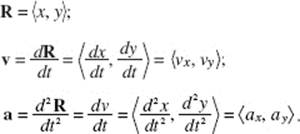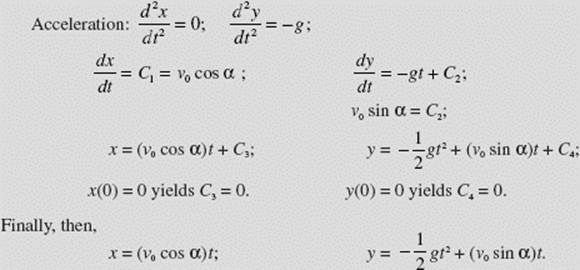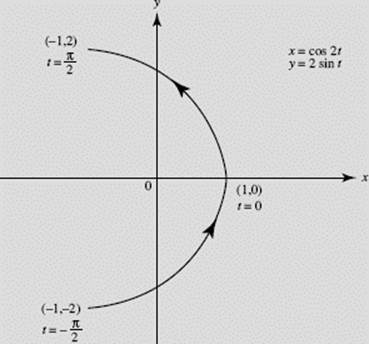Calculus AB and Calculus BC
CHAPTER 8 Further Applications of Integration
B. MOTION ALONG A PLANE CURVE
BC ONLY
In Chapter 4, §K, it was pointed out that, if the motion of a particle P along a curve is given parametrically by the equations x = x(t) and y = y(t), then at time t the position vector R, the velocity vector v, and the acceleration vector a are:

The components in the horizontal and vertical directions of R, v, and a are given respectively by the coefficients of i and j in the corresponding vector. The slope of v is ![]() its magnitude,
its magnitude,

is the speed of the particle, and the velocity vector is tangent to the path. The slope of a is ![]() The distance the particle travels from time t1 to t2, is given by
The distance the particle travels from time t1 to t2, is given by

How integration may be used to solve problems of curvilinear motion is illustrated in the following examples.
BC ONLY
EXAMPLE 4
Suppose a projectile is launched from the origin at an angle of elevation α and initial velocity v0. Find the parametric equations for its flight path.
SOLUTION: We have the following initial conditions:
Position: x(0) = 0; y(0) = 0.
Velocity: ![]()
We start with equations representing acceleration due to gravity and integrate each twice, determining the constants as shown:

If desired, t can be eliminated from this pair of equations to yield a parabola in rectangular coordinates.
EXAMPLE 5
A particle P(x, y) moves along a curve so that
![]() at any time t
at any time t ![]() 0.
0.
At t = 0, x = 1 and y = 0. Find the parametric equations of motion.
SOLUTION: Since ![]() we integrate to get
we integrate to get ![]() and use
and use
x(0) = 1 to find that C = 2. Therefore, ![]() and
and

Since y(0) = 0, this yields C ′ = 1, and so (2) becomes
![]()
Thus the parametric equations are
![]()
BC ONLY
EXAMPLE 6
The particle in Example 5 is in motion for 1 second, 0 ≤ t ≤ 1. Find its position, velocity, speed, and acceleration at t = 1 and the distance it traveled.
SOLUTION: In Example 5 we derived the result ![]() the parametric representation of the particle’s position. Hence its position at t = 1 is
the parametric representation of the particle’s position. Hence its position at t = 1 is ![]()
From P(t) we write the velocity vector:
![]()
Hence, at t = 1 the particle’s velocity is ![]()
Speed is the magnitude of the velocity vector, so after 1 second the particle’s speed is

The particle’s acceleration vector at t = 1 is
![]()
On the interval 0 ≤ t ≤ 1 the distance traveled by the particle is

BC ONLY
EXAMPLE 7
A particle P(x, y) moves along a curve so that its acceleration is given by
![]()
when t = 0, the particle is at (1, 0) with ![]()
(a) Find the position vector R at any time t.
(b) Find a Cartesian equation for the path of the particle, and identify the conic on which P moves.
SOLUTIONS:
(a) ![]() and since
and since ![]() when t = 0, it follows that c1 = c2 = 0. So
when t = 0, it follows that c1 = c2 = 0. So ![]() Also
Also ![]() and since
and since ![]() when t = 0, we see that c3 = c4 = 0. Finally, then,
when t = 0, we see that c3 = c4 = 0. Finally, then,
![]()
(b) From (a) the parametric equations of motion are
x = cos 2t, y = 2 sin t.
By a trigonometric identity,
![]()
P travels in a counterclockwise direction along part of a parabola that has its vertex at (1, 0) and opens to the left. The path of the particle is sketched in Figure N8–1; note that −1 ≤ x ≤ 1, −2 ≤ y ≤ 2.

FIGURE N8–1